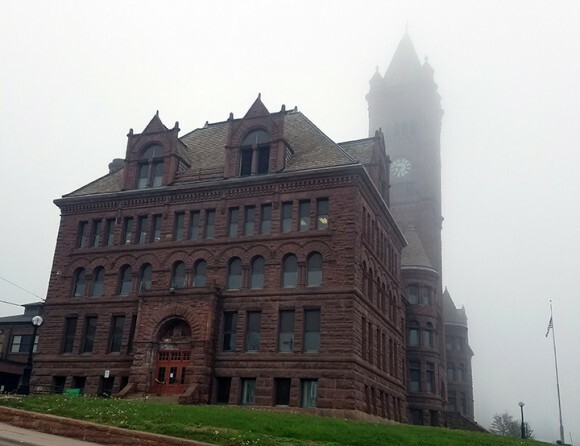Pre-existing conditions

COVID-19 is an especially deadly threat to people already weak and infirm. The fallout from the virus is also very dangerous to businesses and other organizations that were already limping along, over-leveraged and suffering financial distress. In the long and short term, our public school districts are more vulnerable to the corrosive effects of this pandemic than other forms of government. At the moment, Duluth’s public school district is definitely in a very vulnerable position.
COVID-19 is an especially deadly threat to people already weak and infirm. The fallout from the virus is also very dangerous to businesses and other organizations that were already limping along, over-leveraged and suffering financial distress. In the long and short term, our public school districts are more vulnerable to the corrosive effects of this pandemic than other forms of government. At the moment, Duluth’s public school district is definitely in a very vulnerable position.
Slivers of silver lining
As I’ve pointed out before in this column, one of the most egregious errors in the huge investment Duluth made in its public school system was the school board’s failure to factor in a maintenance plan to protect the investment. Besides hundreds of millions poured into facilities, we spent millions on technology during the consolidation project. It cost taxpayers $8 million for the purchase and installation of “Smart Boards” in our classrooms, alone.
“There was a lot of conversation about the fact that those systems would need some ongoing financing plans.” Former Facilities Manager, Kerry Leider, told the News Tribune. Paraphrasing in its report, the paper added that this was “because the large initial investment meant upgrades would be needed all at once.” There was a lot of talk, but no one ever came up with a maintenance plan. Smart Board Technology, already dated when installed, was soon being described as “ancient” by district leaders, who found themselves unable to adjust to their failure.
Instead of putting our school district on the “cutting edge of 21st century technology,” as advertised, the massive investment quickly morphed into a lead weight. Left broke from the millions it had blown, the district was unable to upgrade existing equipment or invest in rapidly evolving new devices. An attempt to get the public to cough up more money through a technology referendum failed.
One silver lining from the pandemic is that Federal funds, flowing in under the CARES ACT, means ISD 709 has been able to invest in some upgraded technology.
Another silver lining is that the Red Plan left our schools with good ventilation systems. There are many caveats to this statement, but having air circulation systems up to current ASHRE (American Society of Heating, Refrigeration and Air Conditioning Engineers) standards, which is 15 CFM (Cubic Feet per Minute,) has obvious advantages when you are dealing with an airborne virus.
Filters used in these types of ventilation systems are rated on a MERV (Minimum Efficiency Reporting Value) scale: MERV 1, MERV 2, all the way up to MERV 16. Media reports have been touting MERV 13 as the standard for removing particulate matter small enough to catch the virus. ISD 709 is using MERV 11. One explanation given to me by the Facilities Manager, Dave Spooner, is budgetary: The filters cost in the neighborhood of $30,000 to $40,000 to change out.
Schools are not like airplanes, which keep re-circulating, filtering and reusing all of the air. At the moment I spoke to Mr. Spooner, air temperatures in Duluth were hovering in the pleasant 70 degree range. Nearly all the schools were using outside air, except in the larger common areas, such as gyms and cafeterias. Interestingly, the MERV 11 filters were filtering pollen, etc. from the outside air.
There are many technical aspects to this subject. A full examination would take up this entire article. ISD 709 has 15 school buildings. 11 of the 15 have ERV (Energy Recovery Ventilation) systems and the other four (Rockridge, Old Central, Stowe and Lakewood) have the more traditional Air Handling (AHU) units. ERV appears to create a more efficient air flow, because it pushes cool clean air into the center of the room along the floor from two separate directions and draws it out through the ceiling, while the air handling units both push and draw from vents in the ceiling.
COVID-19 put a spotlight on school ventilation systems. The University of Minnesota discovered in a study conducted last July that there are disadvantages to using ventilation systems with fine particulate filters: “In indoor spaces, good ventilation will filter some of the virus out of the air, but may leave more particles on surfaces.”
So much information these days needs an asterisk after every sentence. Again, there are a lot of caveats concerning the air control systems we paid big bucks for in our schools. I can’t cover the subject, even on a surface level, without mentioning one of the biggest negatives. The dehumidification (chiller) units require running the boilers in the summer. During the 9/13/17 Business Committee meeting, the Facilities Management’s Building Systems Coordinator said: “To achieve this dehumidification, we do actually have to run the boilers at the same time, for reheating…We’re running the boilers exactly how we’re supposed to, over the summer. That’s one of the downsides of running these chillers: We have to now run the boilers over the summer, as well.”
On 9/13/17, the News Tribune reported that the school district had just completed an analysis of energy savings “that compares 2017 costs to pre-Red Plan numbers.” The paper informed its readers that the analysis “shows projections made a decade ago were nowhere near reality.” Current staff is doing a good job of maintaining the HVAC systems, but running boilers during the summer is likely where some of the highly touted “energy savings” of the Red Plan literally vanishes into the air. In the long run, we’re also going to get fewer years of service out of very expensive boilers.
At the moment, however, the positives of these systems are self-evident. Despite the CDC’s waffling from political pressure about the threat of airborne COVID, I believe most people would agree with Minnesota Department of Health’s Infectious Disease Control Director, Kris Ehresmann: “Better air flow makes a difference in reducing the likelihood of COVID transmission.” If I had to sit in a classroom all day in the midst of a pandemic, I would hope for a good ventilation system.
Worries about in-person learning during a pandemic are compounded by the fact that kids aren’t the only ones in schools. Adults--teachers and other staff--are in the same environment. Besides the personal health risk, kids (and adults) can pick the virus up and bring it home, causing greater community spread to people who are vulnerable. Having up-to-code HVAC systems in schools when you are dealing with a potentially deadly airborne virus does appear to provide some safety. ISD 709 is actually ahead of the game in this regard, compared to a lot of other school districts. We may actually have one reason to celebrate our school district’s half-billion dollar building misadventure.
Persistent budget reality
The most baseline threat of COVID-19 to ISD 709 is budgetary, and anything the district can do to save money is a plus. During the September 8th HR/Finance Committee meeting, the Board was given a presentation about refunding two bonds (2010d and 2012b.) A bond sales representative said the refunding (refinancing at a lower interest rate) would save $669,000, by exchanging current costs with cheaper interest on a new bond sale of $4,095,000.
Again, I applaud saving money, but watching these bond transactions in the boardroom with the DFL running the show over the years has been a little like watching an astrophysicist give a lecture on jet propulsion thrust and gravitational pull to the Dallas Cowboys’ cheerleading squad. DFL and teachers’ union-endorsed board members rubberstamped this entire arrangement, which so profoundly affected our school district. Yet, collectively, current board members from that same camp (still running the show) possess NEGATIVE knowledge about these numbers.
During the discussion, the district’s CFO asked the bond salesman to explain to the Board the difference between a general obligation bond and a C.O.P. (Certificate of Participation.) The salesman explained that C.O.P.s “do not have ‘full term’ in the title, thus (this slick finance shaman actually said ‘thus’) they are payable from the general fund.” Thusly, he pointed out that interest rates on these financing vehicles are extremely high, (especially at a time when the Feds have the benchmark interest rate near zero.) He told our representatives that interest on this debt ranges from 4-to-4.65% for the 2010d debt and 4.25-to-5.25% on the 2012b.
The main reason these particular C.O.P.s have such a high interest rate is because they are a lease/purchase agreement, appropriated annually out of the budget and not backed up by the taxpayers. The other C.O.P.s sold under the Red Plan had a levy attached to them. When the budget started going south, the school board was able to move the burden of all of that debt (without voter approval) onto to the backs of taxpayers.
Just to be clear: We were taken to the cleaners in three ways by this arrangement. (1) Financing through C.O.Ps allowed the school board to deny us a vote on the largest consolidation project in the history of the state. (2) The high interest rates from this type of financing robbed even more money from the district’s general fund. The 2012b C.O.P., for example, will rob nearly $3 million ($2,956,801.22) of interest, or nearly a third of its $9,134,917.50 debt payment. (3) The tax promise made to Duluth in regard to the project’s enormous price tag was smashed to smithereens when millions of C.O.P. debt was shifted onto the tax levy without voter approval in fiscal years `13 and ‘14. It’s also noteworthy to examine payments on the 2012a C.O.P., which will begin next February, ten years after Dixon left town. We will pay 84% interest, or $10,793,672.85 on a $12,801,327.15 bond.
If any school board member brags to you about how they saved $669,000, laugh.
ISD 709 has been a money-devouring black hole since Keith Dixon came to town and needs every penny it can get. The $50 million Duluth taxpayers gave the organization in 2017 ($5 million/year for 10 years) barely made a dent in the need. Basically it allowed the district (with great strain) to balance the budget and keep the reserve fund from crossing the line into negative territory and statutory operating debt status.
“Please let kids go to school all day, Monday through Friday. We have 8 kids in school and it is impossible to participate virtually.”
“I’m a concerned parent of 6 public school students. My concern is with the planned hybrid or distance learning…I feel that the adults making the decisions for a child’s education and well-being are considering themselves more than the children. If distance learning does happen, we will not be participating. We will remove our (6) children from Duluth Public Schools.”
“I am concerned about sending my child to school only one day a week. I tried teaching my child at home with distance learning last year and we both ended up frustrated…Children need hands-on, interactive learning. I fear they will be years behind in their academics, if they are expected to learn by staring at iPads.”
“ISD 709 has damaged relations with residents and parents that I believe is causing long-term damage…There is chatter now about new charter schools which are emerging as more choices to ISD 709. It’s hard for me to say this, but I am now looking at ISD 709 with a distressing posture.”
The Red Plan failed colossally in its enrollment projection, the primary root cause for ISD 709’s financial problems. The district’s enrollment report comes out during the October Business Committee meeting. Those who support our public schools (presumably, nearly all Duluth citizens) cross your fingers the numbers don’t take another nosedive.
